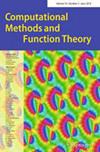作为覆盖图的 $$*$$ - 指数
IF 0.7
4区 数学
Q3 MATHEMATICS
引用次数: 0
摘要
我们运用复分析的工具来构造四元片正则函数的(*)-对数。我们的方法使我们能够实现三个主要目标:我们计算了与\(*\)-指数相关的单色性;我们建立了两个\(*\)-指数的\(*\)-乘积也是\(*\)-指数的充分条件;我们计算了正则函数的\(*\)-指数的切片导数。本文章由计算机程序翻译,如有差异,请以英文原文为准。
The $$*$$ -Exponential as a Covering Map
We employ tools from complex analysis to construct the \(*\)-logarithm of a quaternionic slice regular function. Our approach enables us to achieve three main objectives: we compute the monodromy associated with the \(*\)-exponential; we establish sufficient conditions for the \(*\)-product of two \(*\)-exponentials to also be a \(*\)-exponential; we calculate the slice derivative of the \(*\)-exponential of a regular function.
求助全文
通过发布文献求助,成功后即可免费获取论文全文。
去求助
来源期刊

Computational Methods and Function Theory
MATHEMATICS, APPLIED-MATHEMATICS
CiteScore
3.20
自引率
0.00%
发文量
44
审稿时长
>12 weeks
期刊介绍:
CMFT is an international mathematics journal which publishes carefully selected original research papers in complex analysis (in a broad sense), and on applications or computational methods related to complex analysis. Survey articles of high standard and current interest can be considered for publication as well.
 求助内容:
求助内容: 应助结果提醒方式:
应助结果提醒方式:


